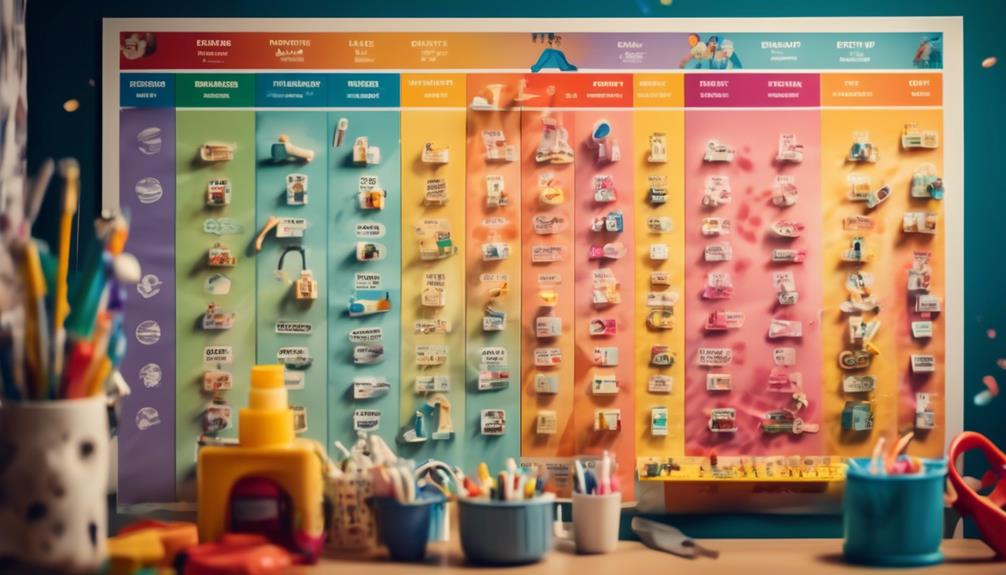How to Create Routine Charts to Promote Self-Discipline in Children

Creating routine charts can be a powerful tool to cultivate self-discipline in children.
This can ultimately lead to academic success, improved emotional well-being, and overall achievement.
By learning how to create effective routine charts, parents and caregivers can inspire and motivate children to develop self-discipline.
Benefits of Routine Charts
Using routine charts can have numerous benefits for children, allowing them to develop self-discipline and cultivate a sense of responsibility. The importance of consistency in routine charts can't be overstated. By providing a clear and structured framework, routine charts instill a sense of stability and predictability in a child's life. This consistency helps them understand the importance of following a schedule and completing tasks in a timely manner.
Moreover, routine charts can greatly improve a child's time management skills. By breaking down tasks into manageable chunks and assigning specific time slots for each activity, children learn to prioritize and allocate their time effectively. This valuable skill not only enables them to accomplish their daily responsibilities but also prepares them for future challenges and deadlines.
Additionally, routine charts foster a sense of accountability. As children track their progress and check off completed tasks, they develop a heightened awareness of their own responsibilities. This sense of ownership encourages them to take pride in their accomplishments and motivates them to consistently strive for excellence.
Choosing the Right Tasks and Responsibilities
Now that you understand the benefits of routine charts and how they contribute to a child's self-discipline and sense of responsibility, it's crucial to carefully consider the tasks and responsibilities that should be included in their chart. Selecting appropriate activities and age-appropriate responsibilities will ensure that your child feels capable and motivated to complete them.
Here are three essential factors to consider when choosing tasks and responsibilities for your child's routine chart:
- Age and Development: Tailor the activities to your child's age and abilities. Younger children may benefit from tasks such as making their bed, tidying up toys, or setting the table. As they grow older, you can gradually introduce more complex responsibilities like doing laundry or helping with meal preparation. By aligning the tasks with their developmental stage, you promote a sense of accomplishment and progress.
- Interests and Passions: Incorporate activities that align with your child's interests. If they enjoy art, include tasks like drawing or painting. If they love nature, encourage them to water plants or help with gardening. By choosing activities that resonate with their passions, you foster a sense of joy and enthusiasm, making it more likely for them to complete the tasks with eagerness.
- Gradual Progression: Introduce tasks and responsibilities gradually, allowing your child to build their skills and confidence over time. Start with simple tasks and gradually increase the complexity and responsibility as they demonstrate competence. This approach encourages a sense of growth and accomplishment, instilling a belief in their abilities.
Designing an Effective Routine Chart
When it comes to designing an effective routine chart for your child, there are a few key points to keep in mind.
Firstly, the visual layout should be clear and easy to understand, allowing your child to easily navigate their daily tasks.
Additionally, it's important to have customizable task categories that can be tailored to your child's specific needs and interests.
Clear Visual Layout
To effectively design a routine chart, ensure that its visual layout is clear and engaging, captivating your child's attention and promoting self-discipline. Here are three key elements to consider when creating a routine chart:
- Visual aids: Incorporate vibrant colors and engaging images that resonate with your child's interests and preferences. These visual cues will make the routine chart visually appealing and easy to follow, encouraging your child to engage with it willingly.
- Time management: Organize the routine chart in a sequential manner, clearly outlining the tasks and activities throughout the day. Use icons or symbols to represent different activities, allowing your child to easily understand and track their progress. This will help your child develop essential time management skills and a sense of responsibility.
- Clear instructions: Provide concise and straightforward instructions for each task or activity on the routine chart. Use simple language that your child can understand and include any necessary details or reminders. This will eliminate confusion and ensure that your child knows exactly what's expected of them.
Customizable Task Categories
Consider the importance of customizable task categories when designing an effective routine chart for your child's self-discipline. By organizing tasks into specific categories, you can provide structure and clarity to their daily routine. This not only helps your child understand their responsibilities but also empowers them to take ownership of their actions. To create a routine chart that truly resonates with your child, it is crucial to tailor the task categories to their unique interests and needs. Allow them to be part of the process by discussing their preferences and involving them in the decision-making. By doing so, you are not only fostering a sense of autonomy but also creating a reward system that aligns with their motivations. Remember, the key is to inspire self-discipline and empower your child to take charge of their routine.
| Morning Tasks | Evening Tasks |
|---|---|
| Make Bed | Brush Teeth |
| Get Dressed | Read a Book |
| Eat Breakfast | Pajama Time |
| Pack School Bag | Settle Down |
| Say Affirmations | Goodnight Kiss |
In this table, you can see an example of customizable task categories for morning and evening routines. Feel free to adapt them to suit your child's preferences and needs.
Setting Realistic Expectations
When it comes to setting realistic expectations for your child's routine, there are a few key points to keep in mind.
First, ensure that the daily goals you set are clear and attainable, allowing your child to experience a sense of accomplishment.
Second, make sure that the tasks assigned are age-appropriate, taking into consideration their abilities and maturity level.
Lastly, consistency is key in establishing a routine that works for both you and your child, providing them with structure and stability.
Clear Daily Goals
Start each day by setting clear and realistic goals for yourself, allowing for a sense of purpose and direction in your daily routine. Establishing these goals not only helps you stay focused, but also promotes self-discipline and personal growth.
To make the most of your daily habits and effectively manage your time, consider the following steps:
- Prioritize tasks: Identify the most important tasks that need to be accomplished during the day. By prioritizing, you ensure that you allocate your time and energy to the most significant activities.
- Break it down: Break larger goals into smaller, manageable tasks. This approach helps prevent overwhelm and allows you to make progress step by step, increasing your chances of success.
- Be flexible: While setting goals is essential, it's equally important to remain flexible. Life is unpredictable, and circumstances may change. Adjust your goals when necessary, maintaining a balance between ambition and adaptability.
Age-Appropriate Tasks
Setting realistic expectations for age-appropriate tasks is key to fostering self-discipline and promoting growth in children. As parents and caregivers, it's our duty to guide our little ones towards independence, teaching them the values of responsibility and accountability.
Age-appropriate chores play a significant role in this process, allowing children to develop essential life skills while instilling a sense of pride and accomplishment.
When assigning tasks, it's crucial to consider the capabilities and developmental stage of your child. Start with simple, achievable tasks that match their age and abilities. Younger children may begin by picking up toys, making their beds, or setting the table.
As they grow older, they can take on more complex responsibilities, such as helping with meal preparation or doing light household chores.
Consistent Routines
To cultivate self-discipline and foster growth in children, it's imperative to establish consistent routines that set realistic expectations. Consistency brings about a multitude of benefits, providing stability and structure in a child's life. It helps them feel secure and confident, as they know what to expect from their daily activities.
By implementing consistent routines, children develop a sense of responsibility and learn to manage their time effectively. They become more self-reliant, as they understand the importance of completing tasks within a given timeframe. Moreover, consistent routines teach children the value of discipline and perseverance, instilling in them the mindset needed to achieve their goals.
Implementing the Routine Chart in Daily Life
Implementing the routine chart into your daily life will empower your children to cultivate self-discipline and embrace structure effortlessly. By implementing routines and establishing consistency, you're providing your children with a framework that will guide them towards a life of balance and success. The routine chart serves as a visual reminder of the tasks and responsibilities that need to be accomplished, fostering a sense of accountability and purpose in your children's lives.
To effectively implement the routine chart, it's crucial to involve your children in the process. Sit down together and discuss the different activities and tasks that need to be included in the chart. Encourage their input and allow them to have a say in how the routine is organized. This won't only give them a sense of ownership over their daily schedule but also help them develop decision-making skills.
Once the routine chart is created, display it in a prominent place where it can be easily seen and referred to throughout the day. Encourage your children to follow the chart and complete their tasks as scheduled. Remember to be consistent in enforcing the routine, as this will help your children develop the self-discipline needed to adhere to the structure.
As you implement the routine chart into your daily life, remember that your role as a parent is to guide and support your children. Be patient and understanding, providing gentle reminders and positive reinforcement along the way. By consistently following the routine chart, your children will gradually internalize the habits of self-discipline and embrace the structure effortlessly.
Tracking Progress and Providing Feedback
As you embark on the journey of tracking progress and providing feedback, you hold the key to unlocking your children's potential and nurturing their growth with wisdom and grace. Tracking progress is a powerful tool that allows you to gauge their development and identify areas for improvement.
Here are three essential ways to effectively track progress and provide motivation for your children's self-discipline:
- Set clear goals: Start by establishing specific and achievable goals that align with your children's abilities and interests. Break these goals down into smaller, manageable tasks, allowing them to track their progress step by step. This won't only give them a sense of accomplishment but also provide motivation to continue moving forward.
- Celebrate milestones: Recognize and celebrate your children's achievements along the way. Whether it's completing a task on their routine chart or reaching a significant milestone, acknowledge their efforts with words of encouragement, small rewards, or quality time together. Celebrating their progress will instill a sense of pride and boost their self-confidence.
- Provide constructive feedback: Feedback is crucial for growth. When providing feedback, focus on the process rather than the outcome. Encourage your children to reflect on their performance, discuss what went well, and identify areas for improvement. Offering constructive feedback in a gentle and supportive manner will help them learn from their mistakes and strive for continuous improvement.
Dealing With Challenges and Setbacks
How can you overcome challenges and setbacks while nurturing your children's self-discipline?
Life is full of obstacles, but it's through facing these challenges head-on that we build resilience in ourselves and in our children. As parents, it's our duty to guide our little ones in developing the fortitude needed to navigate the ups and downs of life.
When setbacks occur, it's important to provide a safe space for your child to express their emotions and reflect on the experience. Encourage them to see setbacks as opportunities for growth and learning rather than as failures. Help them identify the lessons they can learn from the situation and brainstorm strategies for overcoming similar obstacles in the future.
Fostering Long-Term Self-Discipline Skills
To foster long-term self-discipline skills, instill in your child a sense of purpose and the belief that their actions have a direct impact on their future. Building self-discipline habits is a gradual process that requires patience and consistency. Here are three key ways to help your child develop long-term self-discipline skills:
- Set clear goals: Encourage your child to set specific, achievable goals that align with their interests and values. By helping them define their purpose and aspirations, you empower them to see the bigger picture and understand the importance of self-discipline in achieving their dreams.
- Create a positive reinforcement system: Rewarding your child for their efforts and progress is essential in building self-discipline habits. Use a system of praise, small incentives, or privileges to reinforce their positive behavior and motivate them to continue practicing self-discipline.
- Teach resilience and perseverance: Help your child understand that setbacks and challenges are a natural part of life. Encourage them to view failures as learning opportunities and to persist in the face of adversity. By teaching resilience, you equip your child with the tools to stay committed to their goals and develop long-lasting self-discipline skills.
Frequently Asked Questions
How Can Routine Charts Be Used to Promote Self-Discipline in Children With Special Needs?
To promote self-discipline in children with special needs, routine charts are key. Using visual schedules and alternative strategies tailored to their needs can enhance effectiveness. Incorporating routine charts can especially benefit children with ADHD.
Can Routine Charts Be Effective for Children of Different Age Groups?
Routine charts can be highly effective for children of all age groups, as they provide structure and promote self-discipline. They have a significant impact on behavior development, helping children develop responsibility and independence.
What Are Some Alternative Methods to Routine Charts for Promoting Self-Discipline in Children?
To promote self-discipline in children, consider alternatives to routine charts. Explore the power of behavioral rewards and the importance of open parent-child communication. These methods can foster growth and instill a sense of responsibility.
How Long Does It Typically Take for Children to Start Seeing the Benefits of Using Routine Charts?
You will begin to see the benefits of routine charts for your children sooner than you think. With consistency and patience, you'll notice positive changes in their self-discipline and behavior. Keep measuring the effectiveness and enjoy the journey.
Are There Any Potential Drawbacks or Limitations to Using Routine Charts for Promoting Self-Discipline in Children?
When using routine charts to promote self-discipline in children, it's important to be aware of the potential drawbacks and limitations. Over reliance on rewards can hinder intrinsic motivation, and children may struggle to self-regulate without them.











